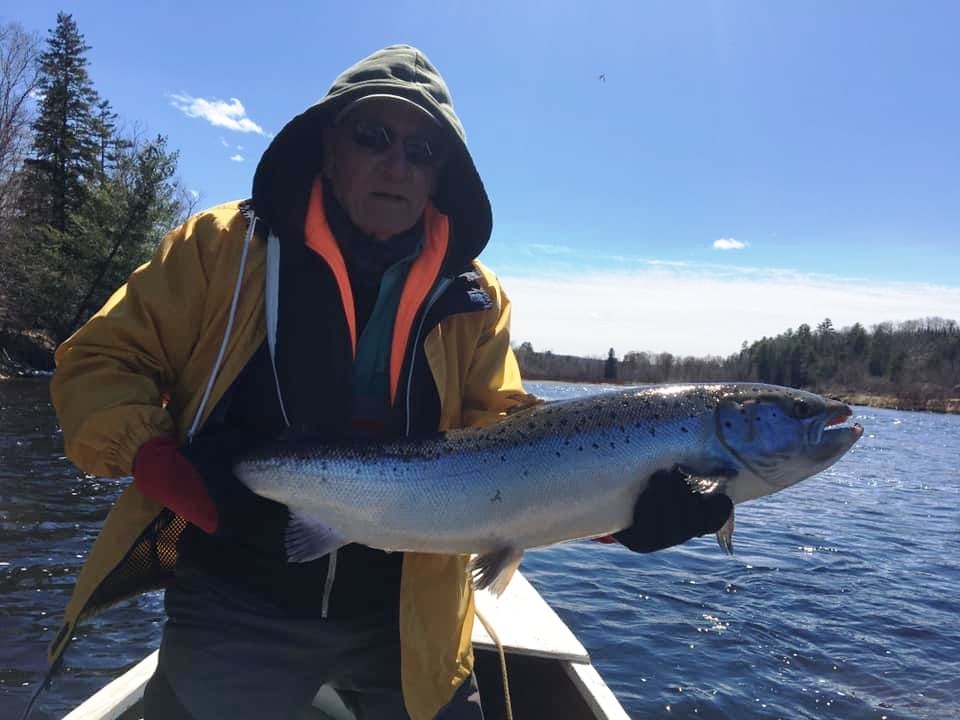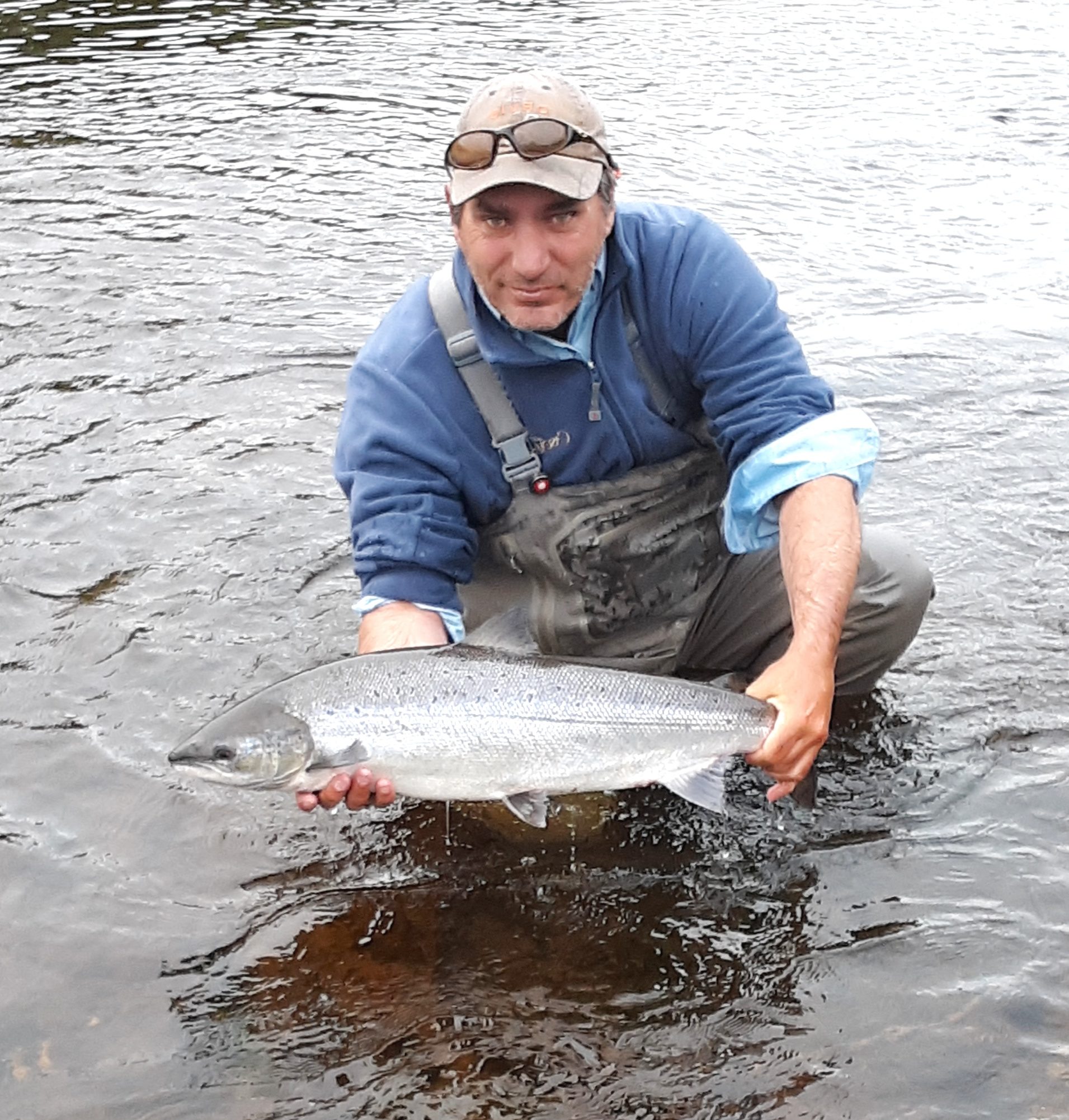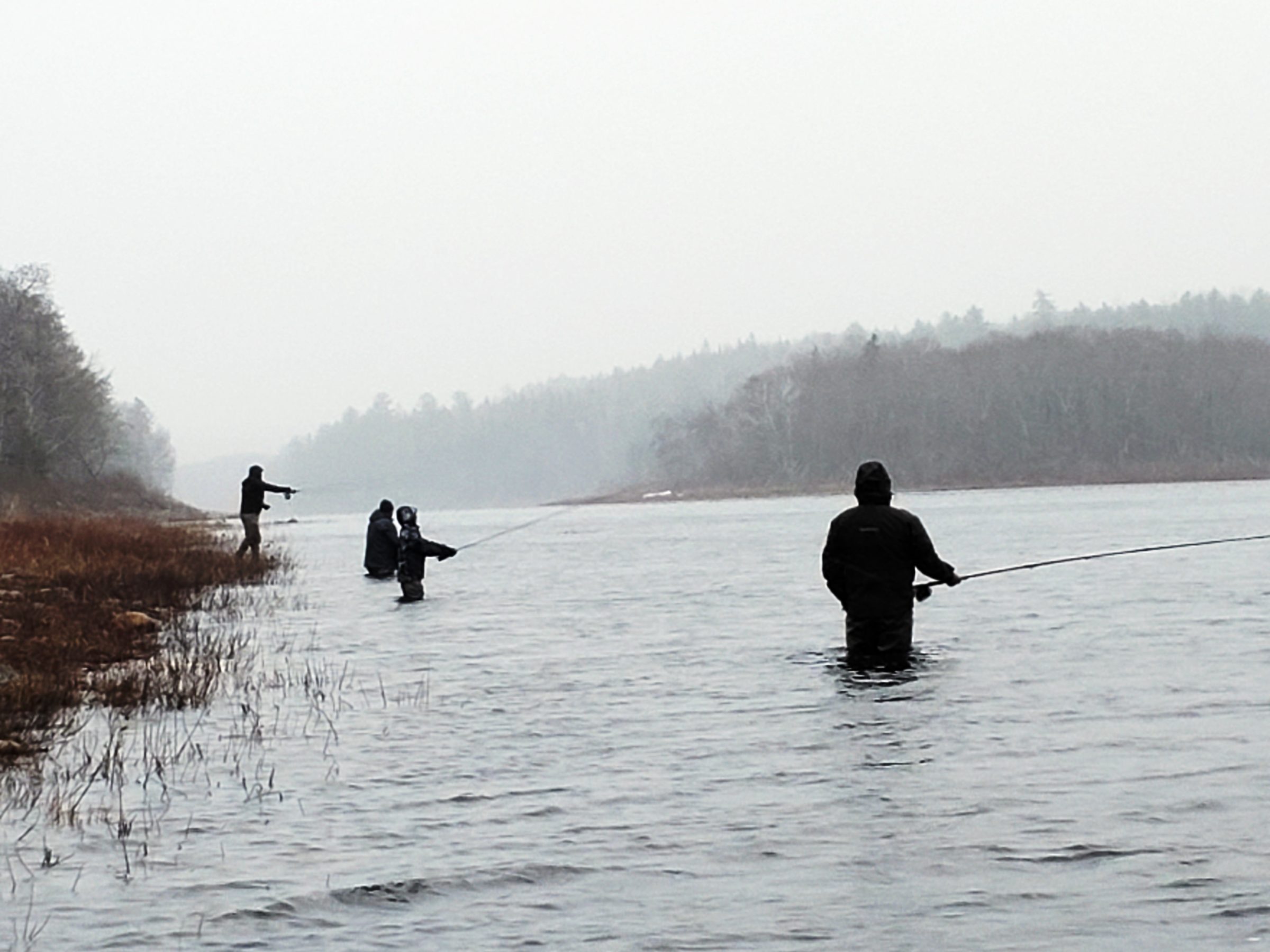
Goodbye Kelts, Prepare for Bright Salmon!
Fishing Friends:

Kurt Allen of Fredericton with one of two well-mended kelts taken on May 7. Note the greening-up taking place on Doctor’s Island in the background.
Spring fishing season doesn’t close for a few days yet, but how long the kelts actually stick around Miramichi River seems to depend on a number of factors. These may include water temperature, water height – strength of flow – and how long it has been since ice out. I haven’t made any attempt to research it, but it seems that even going back 25 years or more to my springs on the Matapedia that the length of time since the ice left the river seems important. It may really be water temperature, and as long as the river is covered with ice the water just doesn’t warm up, but in any case some years the best kelt fishing happens immediately after the season opens and only lasts a week or so, and other years the kelts seem to take their time dropping down the river, and they can be found – especially in the lower river – until late May.
This year it appears that the season is winding down. I haven’t heard or seen much salmon chat on the web for the last few days. I spoke with Karl Wilson at Wilson’s Miramichi Lodge, and with Byron Coughlin at Country Haven in the last day or so. Both reported that there are still a few kelts here and there. Karl had an older couple who wanted to troll on Monday the 3rd, and they got 3 nice salmon up in McNamee. Country Haven’s anglers caught some earlier in the week too, but most of the action has switched to striped bass.

Brett Silliker of Upper Oxbow Adventures guided this sport to an incredibly well-mended kelt on the NW Miramichi
During the week Jason Curtis and Darrell Warren fished together down by Quarryville and reported hordes of stripers there, but caught no salmon or trout. Something really needs to be done about the overpopulation of striped bass that in addition to the NW are clearly spawning now in the SW Miramichi and the Tabusintac, and probably other southern Gulf of Saint Lawrence Rivers. It is often noted that stripers and Atlantic salmon have lived side by side in the Miramichi since before recorded history. That is true, but since Europeans came to the Miramichi there has always – other than the last 20 years – been a commercial fishery for striped bass. When I researched material for On the Cains I found that a commercial fishery netting approximately 300,000 pounds a year took place through much of the 1800s. DFO regulates striped bass as if they were on the verge of extinction, and of course nothing could be further from the truth. Extending a commercial striper season to the gasperaux netters would take a much needed bite out of the surplus striped bass population, and give a lot more smolts a chance to get safely out of the river. Certainly it is also time to do away with the overly restrictive slot limit, and to allow a moderate harvest of even the largest bass. Allowing the retention of any and all striped bass caught above the head of tide is also long overdue. Why in the world would you be required to release a striped bass into a pool full of parr???
None-the-less, in spite of the obstacles, 2020 was an up year for Atlantic salmon in the southern Gulf of Saint Lawrence Rivers. According to ICES “International Council for the Exploration of the Sea” it was the best year for large salmon – other than 2011 – in the last 20 or so. Grilse numbers were not as impressive when compared to 2000 through 2012, but 2020 was definitely an up year compared to the preceding few.
2021 was a great year for kelt fishing, and as the season wound down some very robust specimens were taken. Undoubtedly these fish were well fed on what we hear was an ok smelt run this season. How much food they can find locally is thought to be a prime determiner of whether the kelts go back to sea for a full year or stay in the Gulf of Saint Lawrence and come back in the river to spawn that same fall. Staying local seems to be a lot safer, and that means more salmon in the river to fish for and to lay eggs. Hopefully a good number of the many kelts that were around in late April will be back in the Miramichi again for the fall season. There is reason to be optimistic.
With the much anticipated opening weeks of salmon season already behind us for another year, it is time for one more quick look back at some of the sights of early spring. Jason and Jennifer Curtis hiked up the hill above Buttermilk Brook and sent me a video they took of this landmark on the Cains River. The frothiness of this brook is famous, and looking at it tumbling down this hillside it is easy to see where its name comes from. Check out this LINK IMG_6079
I got this photo from Dawson Hovey just after I sent out my last blog alert. I did add it to my website after I had sent out the alert, but most of you probably missed it, so here it is again. In the photo the Hovey family and friends are fishing at the Kenmore Club a few miles upriver of Boiestown during a cold and snowy late April day. I’m always intrigued by people catching kelts from the shore. In Scotland they are taken early in the season in places like Loch Tay, but for the most part kelts are taken only incidentally in Scotland while fishing for early run bright fish. Speaking of Scotland, fishing is quite good there at the moment. I checked the Fish Dee site and the chat was very upbeat with good runs of fish and the Covid restrictions finally lifted.
On the conservation front the MSA has a couple of additional projects underway beyond the normal full summer and fall schedule of stream survey work. One of these is returning to a smolt population estimate for the S W Miramichi which has not been done in recent years due to the smolt wheels being deployed on the NW branch. Another is a project using DNA work to determine the most effective method of fry stocking. In this approach the survival of fry reared from wild adults will be compared to that resulting from adults raised in a hatchery from wild smolts. This work will be carried out in the Dungarvon River because of its manageable size.
If you haven’t visited the MSA website recently, you will see that a lot of work is going in to keeping it full of up to date information. Follow this link to the MSA website for a full report that covers a number of years of the MSA’s list of field programs. While you are on the site please join the MSA if you are not currently a member. No single thing that you could do would be of more value to strengthening the Miramichi’s wild salmon population than this simple act.
Last, I’m frequently asked if I have any news on opening the border for U.S. anglers to visit NB. Yesterday I googled up “U. S. Canada border opening” and I found a fair amount of relatively new information. First, I see that members of the U.S. Senate from both parties are pushing the point in calling for the opening. I also saw quotes from Premiere Higgs of NB that sound very hopeful for action within a couple of months – dating back from mid-April. It sounds like he very much wants his Province not to miss the summer tourist season. The biggest obstacle seems to be the relatively low levels of inoculation in Canada. As we are seeing now in much of the USA, virtually anyone can get a shot without even an appointment. Maine is now up around 50% for full inoculation and things are looking much brighter than even just a month ago.

Jason Curtis holds a classically shaped June salmon from a couple of years back. It won’t be long now!
Thanks for reading, and keep an eye out for that first bright salmon. Another 10 days or so and one could happen along any time.
Brad Burns



Brad, it’s always a pleasure to read your reports. That NW spring salmon was as nice as any summer salmon; with the exception of the one Jason is holding of course. That is one spectacular fish… Great short video of Buttermilk Brook running high. How I wish it ran that way all summer long… I often think of you and all our other out of province friends. I hope you guys are able to come back to the Miramichi in the very near future.
Thanks Kris, me too. It is getting hard to find Mainers now who don’t have both shots. The situation has to change fairly soon.
Brad – Your comment about DFO’s management of striped bass prompts me to draw a comparison with our “management” of gray seals here in the U.S. Both species were depleted and deserved protection. The issue is knowing when – and having the capacity – to lift that protection. The powers-that-be are too often slow to react, even when the evidence is abundantly clear. You mention Jason and Darrell encountering “hordes of stripers” down near Quarryville. A recent aerial photograph shows hordes of gray seals covering Great Point, on Nantucket – once one of New England’s great fishing destinations. Thanks to the Marine Mammal Protection Act, Great Point is now effectively a seal refuge. In my view, it comes down to a question of balance – doing the best we can to keep the overall ecosystem and the species that comprise it in balance.
Pete – I very much agree. Brad
Brad, enjoy your blog and really enjoyed « On the Cains »
If in doubt, go to the source. Have talked to three salmon fishermen, none of which are familiar with the term well- mended.????? Help.
Hello Mel, thanks for asking. I probably shouldn’t have assumed that well-mended was a common term. The term means a kelt – spring salmon that spawned in the previous fall – that is making good, visible progress in terms of reconditioning.
Thanks Brad. I’m batting 100% . I suspected that was it but the term was foreign to my fishing buddies as well. Thanks. It’s a bad day when you don’t learn something. Tight lines.
Actually with things like Facebook and the internet in general I’m seeing a lot of Scottish terminology and fishing concepts creeping into Miramichi salmon chat. Kelts is definitely one. Tube flies and Spey rods are others, as are things like poly leaders, and early run salmon being called springers. I haven’t heard anyone use the terms of baggots or rawners yet, but probably coming!
Yeah, I knew a rawner once. Those were the days!
Nice blog post Brad I’ve only just caught it.
Hello Henry. Thanks for the comment. Brad